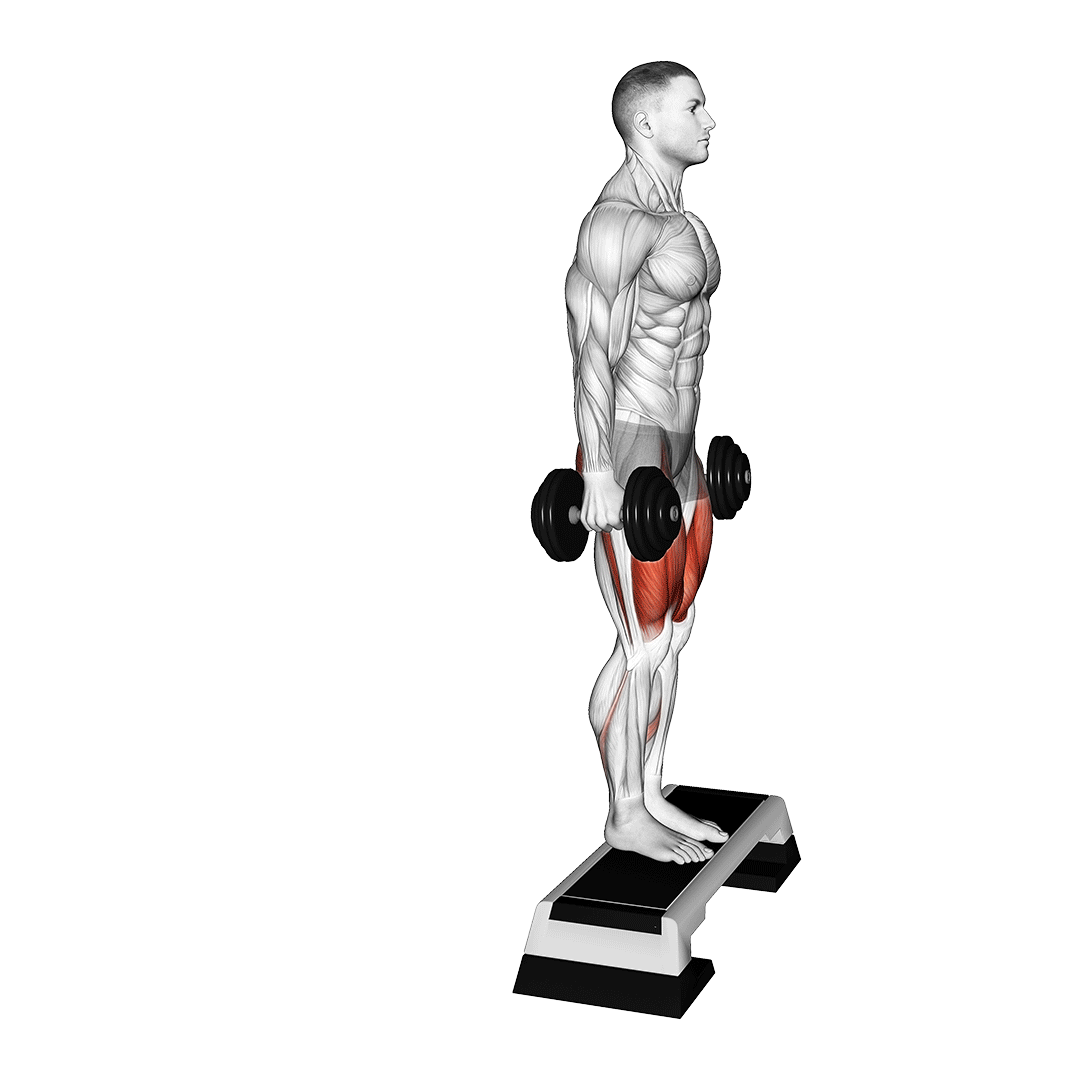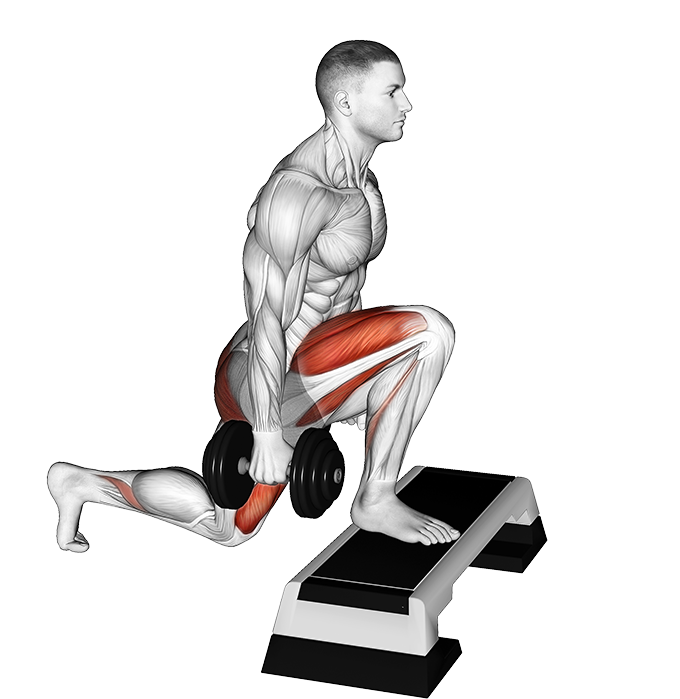Deficit Reverse Lunges Exercise Overview: Muscles Worked and More
The deficit reverse lunge is performed by standing atop an elevated platform and taking one large exaggerated step backwards, the other foot remaining in place.
They are performed for a wide variety of purposes ranging from simple growth of the major lower body muscles (quads, glutes, etc.), protection of the joints, or for sports-specific skill development.
Deficit Reverse Lunges at a Glance
Equipment Requirements
Elevated Platform, Weights (Optional)
Main Muscles Targeted
Quadriceps Femoris, Gluteal Muscles, Hamstrings
Difficulty
Moderate
Sets, Reps, and Load Recommendations
2-3 sets of 6-12 Repetitions at Moderate Load - OR - 3-5 sets of 12-20 Repetitions with Bodyweight
How to Do Deficit Reverse Lunges
- To perform a deficit reverse lunge, the lifter begins by setting both feet flat atop their choice of elevated platform, weights gripped in both hands (if using any).
The toes should be pointed forwards with the heels set slightly wider than hip-width apart, the core lightly braced and the chest upright. - Ensuring they do not lose their balance, the lifter takes one large step backwards with their working leg, landing on the balls of their feet as they bend both knees into a split squat stance.
- As the lifter bends both knees, they will utilize a small amount of hip flexion and hinge the trunk somewhat forwards, distributing their weight more towards the stationary leg as they descend into full split squat depth.
This should end with the rear knee nearly touching the ground, the forward leg’s thigh parallel in angle to the floor. - Now having achieved proper depth, the lifter squeezes their glutes and launches off the working foot, stepping it back atop the platform.
- With both feet returned to the same elevation, the repetition is considered to be complete.
Additional Tips:
If you have difficulty maintaining your balance as you lunge backwards, it is entirely fine to use a nearby object for stability.
Likewise, adjusting the width of your stance (wider generally equates to more stability) and how far forwards your trunk is angled will also help with maintaining proper balance.
Another great tip is to take full advantage of the exercise’s elevated position. Open up the hips when descending into depth, focusing on taking a wider step backwards without touching the working knee to the floor.
Sets and Reps Recommendation:
If performing the exercise with additional weight, less volume is necessary due to the greater intensity of each repetition.
Of course, the opposite is true if performing deficit reverse lunges with bodyweight resistance alone.
For weighted sets, 2-3 sets of 6-12 repetitions at a moderate load will be best. Otherwise, 3-5 sets of 12-20 repetitions should suffice.
What Muscles Do Deficit Reverse Lunges Work?
Deficit reverse lunges are a compound movement, as they target multiple major muscle groups at different points in their movement pattern.

These muscles are the quadriceps femoris, the gluteal muscle group and the various muscles of the hamstrings.
Each muscle group plays a vital role in relation to the knee and hip joints, working through large ranges of motion at a high intensity. To a smaller secondary capacity, the calves will also be targeted as well.
Common Deficit Reverse Lunge Mistakes to Avoid
Though it is indeed true that reverse lunges are far easier on the joints than conventional lunges, avoiding the following mistakes will further ensure a safe and effective workout.
Working Knee Touching the Floor
To maintain tension in the muscles and prevent bruising of the knee, the backwards-facing leg should never touch the floor. Even at maximum depth, the kneecap should still be several inches away from the ground.

Consistently making the mistake of resting the knee on the ground could be a sign that the lifter is failing to step far enough backwards - of which is also another mistake in and of itself.
Stationary Leg Bending Inwards/Adducting
Occasionally, lifters with poor footwear or an excessively wide stance will find that their stationary leg begins to rotate inwards as they step backwards.
This can appear as if the thigh is angled towards the opposite side, or that the ankle is rolling inwards, even if the knee remains pointing forwards.
Regardless of what form it takes, repeatedly doing so will increase wear and strain on the joints of the stationary leg - as well as greatly reduce stability. Try performing the exercise with different footwear and a more narrow stance.
Not Stepping Back Far Enough
Failing to step the rear leg back far enough will lead to an excessively forward knee angle and generally poor technique as a whole.
Though it will depend on individual mobility and proportions, lifters will want to step far enough back that only the balls of their feet can remain on the ground, their heel instead pointing straight up into the air.
If the heel can rest further back (or even touch the ground), then the rear leg is not far enough backwards.
Excessively Vertical Trunk Orientation
To maximize posterior chain recruitment and reduce direct vertical pressure on the stationary knee, lifters should seek to hinge their torso forwards between 10-20 degrees.
An excessively vertical trunk angle will not only increase knee strain and reduce the involvement of the glutes, but also potentially disbalance the lifter if their heel is not firmly planted.
Who Should Do Deficit Reverse Lunges?
Deficit reverse lunges are suitable for the majority of athletes and lifters seeking lower body growth - but are particularly useful for those that find conventional lunges too hard on the knees and ankles.
References
1. Graham, John F MS, CSCS*D, FNSCA. Exercise: Barbell Backward Lunge. Strength and Conditioning Journal 33(4):p 80-82, August 2011. | DOI: 10.1519/SSC.0b013e31820e6a7c

